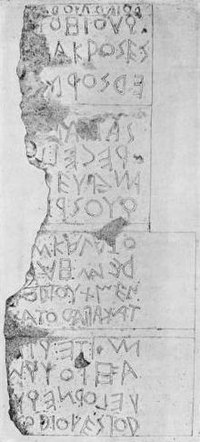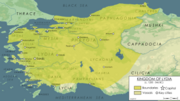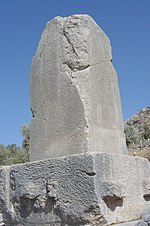Luwian (/ˈluːwiən/), sometimes known as Luvian or Luish, is an ancient language, or group of languages, within the Anatolian branch of the Indo-European...
39 KB (4,534 words) - 15:20, 21 September 2024
The Luwians /ˈluːwiənz/ were an ancient people in Anatolia who spoke the Luwian language. During the Bronze Age, Luwians formed part of the population...
17 KB (1,781 words) - 00:32, 16 April 2024
Hieroglyphic Luwian (luwili) is a variant of the Luwian language, recorded in official and royal seals and a small number of monumental inscriptions....
12 KB (1,383 words) - 19:57, 12 September 2024
Indo-European languages. By the Late Bronze Age, Hittite had started losing ground to its close relative Luwian. It appears that Luwian was the most widely...
38 KB (3,515 words) - 04:57, 15 September 2024
hieroglyphic Luwian survived until the conquest of the Neo-Hittite kingdoms by Assyria, and alphabetic inscriptions in Anatolian languages are fragmentarily...
43 KB (4,809 words) - 19:49, 2 September 2024
Anatolian hieroglyphs (redirect from Luwian language hieroglyphs)
known as Hittite hieroglyphs, but the language they encode proved to be Luwian, not Hittite, and the term Luwian hieroglyphs is used in English publications...
60 KB (1,625 words) - 23:23, 28 August 2024
Iron Age or Late Luwian period. During the Bronze Age, the Luwians were under the control of the Hittites. They spoke the Luwian language, a close relative...
12 KB (1,774 words) - 08:32, 2 September 2024
Tiwaz (stem: Tiwad-) was the Luwian Sun-god. He was among the most important gods of the Luwians. The name of the Proto-Anatolian Sun god can be reconstructed...
6 KB (772 words) - 00:37, 20 May 2024
Boustrophedon (category Articles containing Ancient Greek (to 1453)-language text)
original wooden type). The Luwian language had a version, Hieroglyphic Luwian, that is read in boustrophedon style (most of the language was written down in...
12 KB (1,333 words) - 22:56, 14 August 2024
derived from Luwian and thus Indo-European. Isaurian names containing clear Anatolian roots include Οαδας Oadas, Τροκονδας Trokondas (cf. Luwian Tarḫunt,...
3 KB (254 words) - 06:23, 10 April 2024
Crete (category Articles containing Cuneiform Luwian-language text)
Its etymology is unknown. One proposal derives it from a hypothetical Luwian word *kursatta (compare kursawar 'island', kursattar 'cutting, sliver')...
104 KB (10,639 words) - 15:09, 23 September 2024
was part of the Luwian language family. However, only a few words can be derived from Luwian roots, like maśara 'for the gods' (Luwian masan(i)-, 'god'...
14 KB (1,135 words) - 16:48, 20 September 2024
Lydia (category Articles containing Hieroglyphic Luwian-language text)
Sea on the other. The Lydian language was an Indo-European language in the Anatolian language family, related to Luwian and Hittite. Due to its fragmentary...
70 KB (7,486 words) - 14:31, 25 August 2024
Hittites (category CS1 French-language sources (fr))
family; along with the closely related Luwian language, it is the oldest historically attested Indo-European language. The history of the Hittite civilization...
97 KB (11,193 words) - 21:42, 5 September 2024
Gyges of Lydia (category Articles containing Cuneiform Luwian-language text)
evolved Hittite ḫuḫḫa- (𒄷𒄴𒄩), Luwian ḫūḫa- (𒄷𒌋𒄩) and huha- (𔕳𔓷), and Lycian xuga- (𐊜𐊒𐊄𐊀) in the Anatolian languages family, as well as Latin avus...
34 KB (3,998 words) - 05:34, 29 July 2024
Bodrum (category Articles containing Hieroglyphic Luwian-language text)
cognate with Luwian word "ha+ra/i-na-sà", which means fortress. If so, the city's ancient name was probably borrowed from Carian, a Luwic language native to...
49 KB (4,461 words) - 16:25, 11 September 2024
probably falls outside the centum–satem division; for instance, the Luwian language indicates that all three dorsal consonant rows survived separately...
48 KB (5,866 words) - 19:29, 22 June 2024
Indo-European. Palaic shared common innovations with Luwian not present in Old Hittite, suggesting a prior Luwian-Palaic linguistic complex. It has been characterized...
9 KB (826 words) - 20:21, 15 September 2024
Carchemish (category Articles containing Hieroglyphic Luwian-language text)
structures, temples, palaces, and numerous basalt statues and reliefs with Luwian hieroglyphic inscriptions. Between 1956 and 1998, the whole site had been...
41 KB (4,896 words) - 09:34, 3 August 2024
Cappadocia (category Articles containing Turkish-language text)
Persian name is Katpatuka. It was proposed that Kat-patuka came from the Luwian language, meaning "Low Country". Subsequent research suggests that the adverb...
45 KB (4,626 words) - 17:47, 6 September 2024
BC. In the context of Luwian Studies, Luwian, however, is a toponym encompassing peoples of different ethnicity and languages. It is thus an abstract...
15 KB (1,546 words) - 19:58, 30 June 2024
certain that there was one single language used in the city at the time. One candidate language is Luwian, an Anatolian language which was widely spoken in Western...
15 KB (1,696 words) - 13:51, 19 August 2024
Hittite, the Luwian language does not contain loanwords from Hattic, indicating that it was initially spoken in western Anatolia. The Luwians inhabited a...
11 KB (1,055 words) - 21:40, 5 September 2024
Ḫiyawa (category Articles containing Hieroglyphic Luwian-language text)
cuneiform script. Ḫiyawa (Hieroglyphic Luwian: 𔗒𔓱𔗬𔔂) or Adanawa (Hieroglyphic Luwian: 𔐓𔗢𔗬𔔂) was a Luwian-speaking Syro-Hittite state which existed...
67 KB (7,635 words) - 08:09, 25 September 2024
Lydian religion (category Articles containing Hieroglyphic Luwian-language text)
have been put forward for it: it has been tentatively suggested to be from Luwian kuwalan-, meaning lit. 'army', possibly linked to the role of the Greek...
34 KB (4,085 words) - 06:48, 26 August 2024
block containing Anatolian hieroglyphs, used to write the extinct Luwian language. The following Unicode-related documents record the purpose and process...
4 KB (76 words) - 01:34, 26 July 2024
Name of Syria (category Articles containing Hieroglyphic Luwian-language text)
interest, both among ancient writers and modern scholars. In early Hittite, Luwian, Cilician and Greek usage between the 9th century BC and 2nd century BC...
28 KB (2,895 words) - 17:18, 22 July 2024
Syro-Hittite states (redirect from Luwian-Aramean states)
Neo-Hittite, Syro-Hittite (in older literature), or Luwian-Aramean (in modern scholarly works) were Luwian and Aramean regional polities of the Iron Age, situated...
21 KB (2,317 words) - 16:14, 17 June 2024
the subgroup are localized daughter languages of Luwian. Of the Luwic languages, only the Luwian parent language is attested prior to 1000 BC, so it is...
34 KB (2,638 words) - 00:53, 17 September 2024
Miletus (category Articles containing Greek-language text)
Minor from c. 1450 to 1100 BC. The 13th century BC saw the arrival of Luwian language speakers from south central Anatolia calling themselves the Carians...
37 KB (4,295 words) - 15:06, 19 June 2024



















